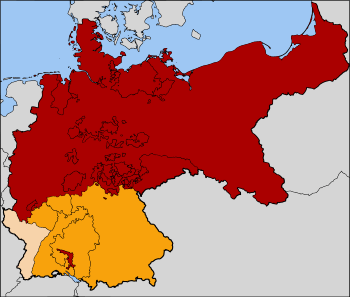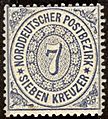North German Confederation facts for kids
Quick facts for kids
North German Confederation
Norddeutscher Bund
|
|||||||||
|---|---|---|---|---|---|---|---|---|---|
| 1866–1870 | |||||||||

The North German Confederation (red). The southern German states that joined in 1871 to form the German Empire are in orange. Alsace-Lorraine, the territory annexed following the Franco-Prussian War of 1871, is in a paler orange.
|
|||||||||
| Capital | Berlin | ||||||||
| Presidency | |||||||||
| Chancellor | |||||||||
| History | |||||||||
|
• Constitution tabelled
|
16 April 1866 | ||||||||
|
• Federation formed
|
1 July | ||||||||
| 18 January 1870 | |||||||||
| ISO 3166 code | DE | ||||||||
|
|||||||||
The North German Confederation (German: Norddeutscher Bund) was a group of states in northern Germany. It started as a military alliance of 22 states in August 1866. Later, it became a single federal state.
Before this, many German states were part of a Zollverein. This was a customs union that allowed free trade between them. The Kingdom of Prussia was the most powerful state in the Confederation. On July 1, 1867, a new constitution officially made the alliance a federal state.
Contents
How the Confederation Began
A long rivalry between Austria and Prussia led to the Austro-Prussian War in 1866. One reason for the war was the future of Schleswig-Holstein. Prussia wanted to take control of this area. After Prussia won the war, it could change the political map of Northern Germany. This area was north of the Main River. The main leader in Prussia was Minister President Otto von Bismarck. He worked for King William I.
On August 18, 1866, Prussia and most North German states signed the August Treaty. They agreed to form a military alliance. They also planned to create a federal state. A federal state has a central government and laws. But the individual states still keep some power. People had thought about forming a federal state in Germany since 1848.
Forming the Union
Bismarck and the allied governments wrote a plan for the North German constitution. They held an election in February 1867. This election chose a group called the konstituierender Reichstag. This group represented the people of Northern Germany. After some changes, the states' governments and parliaments agreed to the final plan. The constitution officially started on July 1, 1867.
How the Government Worked
The constitution said that two main groups would make laws.
- The Reichstag was the parliament. All men over 25 years old could vote for its members.
- The Federal Council represented the governments of the different states.
The King of Prussia was the head of the Confederation. This role was called the Bundespräsidium. The King chose the Federal Chancellor. This Chancellor was the main federal minister. They were the head of the government.
Becoming the German Empire
In 1870, the Franco-Prussian War began. During this war, the South German states joined the North German Confederation. A new constitution was made on January 1, 1871. This constitution changed the country's name from 'North German Confederation' to 'German Empire'. The King of Prussia, who was the head of the Confederation, also became the Emperor. The way the government worked and the flag stayed the same.
The modern country of Germany is still connected to the North German Confederation. Laws and international agreements from 1867-1870 are still valid today. Between 1867 and 1878, Germany became much more modern and united. The North German Confederation brought in the metric system. It also created a modern criminal law book and gave equal rights to all religions. It even started a postal union.
Postage Stamps
The Confederation managed the mail system. It started issuing postage stamps after January 1, 1868. However, the Confederation did not have its own money. So, different stamps were needed for different areas. Stamps valued in groschen were used in the north. Stamps valued in kreuzer were used in the Southern District. All these stamps had "NORDDEUTSCHER POSTBEZIRK" (North German Postal Area) written on them.
A special set of stamps was printed just for Hamburg. These stamps also said "STADTPOSTBRIEF HAMBURG".
List of Member States
| State | Capital | |
|---|---|---|
| Kingdoms (Königreiche) | ||
| Prussia (Preußen) (including Lauenburg) |
Berlin | |
| Saxony (Sachsen) | Dresden | |
| Grand duchies (Großherzogtümer) | ||
| Hesse (Hessen) (Only Upper Hesse, the province north of the Main River) |
Giessen | |
| Mecklenburg-Schwerin | Schwerin | |
| Mecklenburg-Strelitz | Neustrelitz | |
| Oldenburg | Oldenburg | |
| Saxe-Weimar-Eisenach (Sachsen-Weimar-Eisenach) | Weimar | |
| Duchies (Herzogtümer) | ||
| Anhalt | Dessau | |
| Brunswick (Braunschweig) | Braunschweig | |
| Saxe-Altenburg (Sachsen-Altenburg) | Altenburg | |
| Saxe-Coburg and Gotha (Sachsen-Coburg und Gotha) | Coburg | |
| Saxe-Meiningen (Sachsen-Meiningen) | Meiningen | |
| Principalities (Fürstentümer) | ||
| Lippe | Detmold | |
| Reuss, junior line | Gera | |
| Reuss, senior line | Greiz | |
| Schaumburg-Lippe | Bückeburg | |
| Schwarzburg-Rudolstadt | Rudolstadt | |
| Schwarzburg-Sondershausen | Sondershausen | |
| Waldeck-Pyrmont | Arolsen | |
| Free Hanseatic cities (Freie Hansestädte) | ||
| Bremen | ||
| Hamburg | ||
| Lübeck | ||
Images for kids
See also
 In Spanish: Confederación Alemana del Norte para niños
In Spanish: Confederación Alemana del Norte para niños




